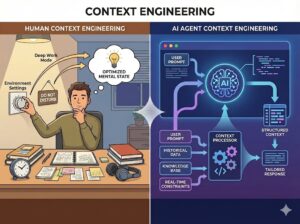How to Become an AI-First Company
Summary Insight:
To scale AI intelligently, you must centralize first—then unleash innovation at the edges.
Key Takeaways:
- Scattered AI tools create data silos, misalignment, and waste.
- A centralized AI Intelligence Layer unifies data, tools, and strategy.
- Startups win by default—unless incumbents centralize to move fast.
If you’re a CEO grappling with how to integrate AI into your company, you’re not alone. The hype is deafening: AI will transform your business, streamline operations, and outsmart competitors. But here’s the dirty secret—most companies are botching their AI adoption. They’re scattering AI tools across silos, creating a chaotic mess of incompatible systems, misaligned goals, and missed opportunities.
The answer isn’t what you’d expect. To unleash AI’s power, you must centralize it first. Yes, centralize. But not in the stifling, bureaucratic way that kills innovation. Done right, a centralized AI Intelligence Layer is the key to decentralized, agile, and transformative AI usage across your organization. Let’s unpack why and how to make your company a true AI-first leader.
The Myth of Bottoms-Up AI
Picture this: Your marketing team adopts one AI tool for customer insights. Operations picks another for supply chain optimization. Sales grabs a third for CRM. Each team thinks they’re innovating, but the result? A Frankenstein’s monster of disconnected systems, duplicated efforts, and data that doesn’t talk to each other. Without cohesion, your AI initiatives are like a band playing different songs at once.
This decentralization trap is deadly. It fragments your proprietary data, misaligns AI with your strategic goals, and creates governance nightmares. Worse, it leaves you vulnerable to startups. While you’re wrestling with internal chaos, nimble startups are building AI-first companies from the ground up. They’re not weighed down by legacy systems or bureaucratic inertia. They move fast, experiment relentlessly, and integrate AI into their DNA. If you’re an incumbent, clinging to control or paralyzed by fear of change, you’re already losing.
The AI Intelligence Layer: Your Centralized Command Center
So, how do you avoid the trap and leapfrog the competition? By building an AI Intelligence Layer—a centralized framework that integrates your AI tools, APIs, proprietary data, goals, people, processes, and governance. Think of it as the nervous system of your AI-first company. It doesn’t dictate every move; it coordinates and empowers every part of the organization to act intelligently and cohesively.
The AI Intelligence Layer does three critical things:
- Unifies Data and Tools: It connects your proprietary data—customer insights, operational metrics, financials—with best-in-class AI tools and APIs. No more silos. Your teams access a single source of truth, ensuring AI outputs are consistent and actionable.
- Aligns AI with Strategy: It embeds your company’s goals into the AI framework. Whether you’re optimizing for growth, efficiency, or innovation, the layer ensures every AI application serves the big picture, not just departmental whims.
- Enables Decentralized Innovation: Here’s the magic—centralization doesn’t mean control. By providing a robust, governed platform, the AI Intelligence Layer frees your teams to experiment, customize, and deploy AI solutions rapidly. It’s the foundation for decentralized creativity, not a bottleneck.
Learning from AWS: Centralize to Liberate
This isn’t a new concept. Cast your mind back to the early days of cloud computing. Amazon Web Services (AWS) didn’t become a juggernaut by accident. Jeff Bezos mandated that all Amazon teams use AWS as their infrastructure backbone. Teams could choose their own tools and approaches, but the underlying platform had to be AWS. This centralized mandate created a cohesive ecosystem, drove relentless innovation, and turned AWS into the cloud’s gold standard.
The same principle applies to AI. A centralized AI Intelligence Layer is your company’s internal AWS. It’s the non-negotiable foundation that ensures scalability, security, and alignment while giving your teams the freedom to build, test, and iterate. Without it, you’re not an AI-first company—you’re an AI-last one, cobbling together tools and praying for miracles.
Why Startups Are Winning (and How You Can Catch Up)
Startups have a natural edge in this AI race. They’re not shackled by legacy systems or risk-averse cultures. They can design AI-first architectures from scratch, embedding intelligence into every process. Meanwhile, many incumbents are too controlling, afraid, or bureaucratic to move swiftly. They hoard decision-making at the top, stifle experimentation, and treat AI like a shiny toy rather than a strategic imperative.
But you can flip the script. By embracing a centralized AI Intelligence Layer, you can match the agility of startups while leveraging your scale, resources, and market position. The key is to act decisively. Don’t let fear of disruption or internal politics slow you down. Build the layer, align your organization, and unleash your teams to innovate like never before.
Becoming AI-First: Your Next Steps
Becoming an AI-first company isn’t about buying the flashiest AI tools or hiring the most PhDs. It’s about structuring your organization for speed, cohesion, and impact. The AI Intelligence Layer is the backbone of that structure. It’s how you centralize to decentralize, turning AI from a buzzword into a competitive weapon.
If you’re ready to transform your company, don’t go it alone. At Organizational Physics, we specialize in helping CEOs like you align strategy, structure, and execution for rapid growth. Our proven frameworks, rooted in first principles, will guide you to build an AI Intelligence Layer that powers innovation and growth.
Take the first step. Visit organizationalphysics.com to explore our resources and connect with me directly. Let’s make your company not just AI-ready, but AI-first. The future isn’t waiting and neither should you.




